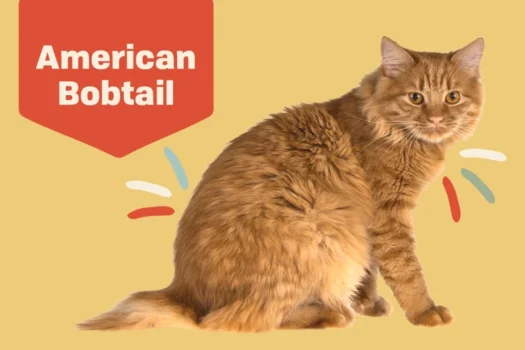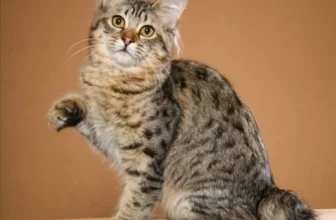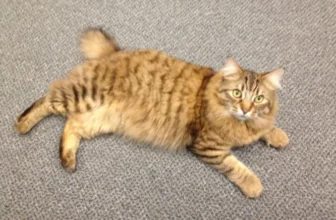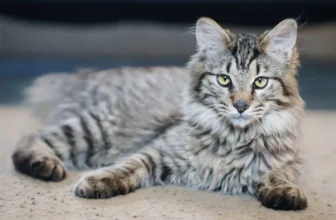If you’re a fan of felines, then you’ve likely heard of the American Bobtail breed. These cats are known for their unique bobbed tails, friendly personalities, and striking appearance. But have you ever wondered how the American Bobtail breed standard has evolved over time? From the early days of the breed to the modern standards of today, there have been many changes and advancements. In this article, we’ll delve into the fascinating history of the American Bobtail breed and explore the various iterations of their breed standards. So, buckle up and let’s dive into the world of the American Bobtail!
The Early Days of the American Bobtail Breed
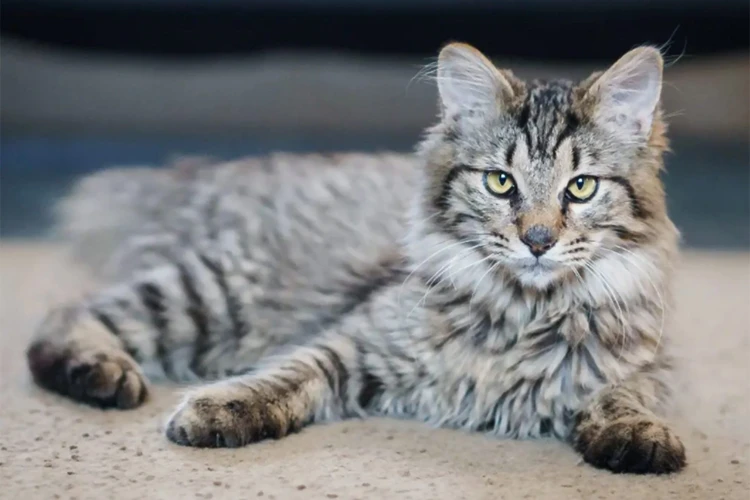
When we look at the American Bobtail breed today, it’s hard to imagine the origins of this unique and beloved breed. However, like all animal breeds, the American Bobtail had to start somewhere. The early days of the American Bobtail breed were marked by experimentation, crossbreeding, and a growing interest in creating a new type of feline companion. This eventually led to the creation of the first breed standard and set the stage for the continued evolution of this wonderful breed. To understand how the American Bobtail breed standard has evolved over time, it’s important to start at the beginning and explore the early history of these fascinating cats. To do so, let’s take a closer look at the origins and early evolution of the American Bobtail breed. For this, you can use relevant information from this link /american-bobtail-origins/.
A Brief History of the American Bobtail
The American Bobtail is an interesting breed that has a unique history. It is believed that the breed originated in the late 1960s when a short-tailed kitten was found on an Indian reservation in Arizona. This breed has a distinct bobtail, which is usually one-third to one-half the length of a normal cat’s tail.
While the exact origin of this breed is still unknown, it is believed that it may have been the result of natural genetic mutations. Interestingly, the bobtail gene is not exclusive to the American Bobtail breed. It has been found in other breeds too, such as the Manx and the Japanese Bobtail.
The American Bobtail started to gain attention in the cat breeding community during the 1970s. Breeders were eager to develop a new breed that combined the physical characteristics of the wild lynx with the temperament of a domestic cat.
The breed’s first cat was a male named Yodie, who was found in the 1980s. He was crossed with a Siamese cat, and this crossbreeding produced a litter of kittens with the distinctive bobtail.
As the breed gained popularity, breeders worked tirelessly to develop and improve the American Bobtail breed. Crossbreeding was a common practice, and breeders introduced new bloodlines to the gene pool to enhance certain physical characteristics and temperaments in the breed. This allowed the breed to continue to evolve and improve over time.
The American Bobtail’s history is very fascinating. As the breed has evolved, it has become a distinctive and impressive breed. Those who are interested in learning more about the breed may find it fascinating to explore the different factors that influence their development, such as crossbreeding, environmental factors, and genetics.
The First Breed Standards
The early days of the American Bobtail breed were filled with uncertainty and lacked a formal standard for appearance and temperament. It wasn’t until the late 1960s when the breed began to take shape, thanks to the efforts of a handful of dedicated breeders. These early pioneers had a vision for a distinctive breed that had a wild appearance and a gentle disposition. They sought to create a breed that would appeal to both cat lovers and those who admired the beauty of wild cats.
The First Breed Standards
The first breed standards for the American Bobtail were established in the 1970s. At the time, the standards focused primarily on the appearance of the breed. According to the standards, the American Bobtail should have a short, sturdy body with a tail that was half the length of a normal cat’s tail. The tail should also have a “bobbed” appearance with a kink at the end.
In addition to their distinctive tails, the standards called for American Bobtails to have large, expressive eyes, and broad, powerful heads with a square-shaped muzzle. The breed should also have a thick, dense coat that could come in a variety of colors and patterns.
Although the early breed standards were primarily focused on appearance, there was also a focus on temperament. The breeders who established the early standards wanted American Bobtails to have a friendly, affectionate disposition that would make them ideal family pets.
These early breed standards were just the beginning for the American Bobtail breed. Over time, the standards would evolve as the breeders worked to refine the breed’s appearance and temperament. Today, the American Bobtail is a distinct and beloved breed with a rich history and a bright future.
Learn how Crossbreeding has impacted the evolution of the American Bobtail.
Changes to the American Bobtail Breed Standard
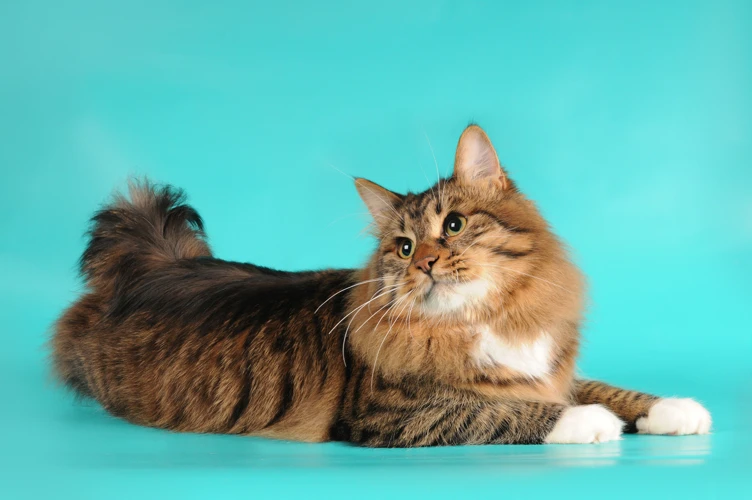
As with any breed of cat, the American Bobtail has evolved and changed over time. Changes to the breed standard have been made for a variety of reasons, from advancements in health and genetics to changing attitudes toward show cats. In this section, we will explore the ways in which the American Bobtail breed standard has shifted since its creation, including the impact of crossbreeding and the influence of the environment and climate. Let’s dive in and see how the American Bobtail has transformed throughout the years.
Advancements in Health and Genetics
Over time, the American Bobtail breed has undergone changes not only in appearance but in genetics and health as well. Breeders and geneticists have made significant advancements that have contributed to the overall improvement of the breed.
One of the most notable advancements in health and genetics is the reduction of genetic disorders within the breed. The breeders have worked to develop health screening programs that assess the likelihood of potential health issues in breeding pairs, and they now conduct genetic testing to identify any inherited traits or disorders that could be passed on to their offspring. These measures have greatly improved the overall health of the American Bobtail breed.
Another important advancement in genetics is the careful selection of breeding pairs. Breeders are looking to match cats that have complementary traits which produce healthy, diverse, and quality litters. There is a focus on breeding cats with a healthy coat, strong bone structure, and a well-proportioned body.
In terms of temperament, breeders have also focused on producing cats that have a calm and docile character. The American Bobtail breed is known for its affectionate and playful personality, and breeders are careful not to breeding cats that are overly aggressive or anxious.
Advancements in genetics and health have significantly improved the American Bobtail breed. Breeders have made great strides in reducing genetic disorders, selecting healthy breeding pairs, and producing cats with an ideal temperament. To learn more about the characteristics of American Bobtail or the impact of crossbreeding, check out American Bobtail Characteristics or The Impact of Crossbreeding on American Bobtail Evolution.
Updates to Appearance and Physical Characteristics
Over time, the American Bobtail breed standard has evolved to include updates to physical characteristics and appearance. These changes have been made to both improve the health of the breed and enhance its unique features that distinguish it from other breeds.
One of the most distinct features of the American Bobtail is its short tail, which can be straight, curved, or kinked, and should not exceed two-thirds the length of a normal cat tail. However, as breeders continue to develop the breed, there have been some updates to the tail requirements. Previously, the breed standard stated that the tail could be no longer than the hock joint, but this has since been changed to allow for slightly longer tails, as long as they are still shorter than a typical domestic cat’s tail.
Another update to the breed standard has been made to the American Bobtail’s coat. According to the Cat Fanciers’ Association (CFA), the American Bobtail can come in both long and short hair coats. The CFA’s breed standard mandates that the coat can come in any color or pattern.
To be considered a true American Bobtail, the cat must also have a muscular, athletic build. The chest should be broad and the legs should be strong and thick-boned. The head should be a large, modified wedge shape, proportionate to the body size. The eyes should be almond-shaped and colors can vary. Ears can be tufted or non-tufted, but should be wide at the base and slightly rounded at the tips.
The updates to the American Bobtail breed standard have been made to ensure the continued health and uniqueness of the cat breed. As breeders continue to work on the evolution of the breed, it will be interesting to see what physical characteristics and traits are next in line for changes.
For more information on the connection between environment and climate and the evolution of the American Bobtail breed, check out our article on how the environment and climate have impacted the American Bobtail breed.
Changing Attitudes Toward Show Cats
As the American Bobtail breed gained popularity in cat shows, so did the attitudes towards show cats. In the early days of cat shows, the emphasis was on conformity to the breed standard, with judges awarding prizes to the cats that most closely resembled the ideal. However, in recent years, there has been a shift towards recognizing cats that exhibit individuality and personality in addition to conforming to breed standards.
This change in attitude has been reflected in the American Bobtail breed standard, with an emphasis on temperament and personality as well as physical appearance. The current breed standard describes the American Bobtail as being alert, playful, and affectionate, with a tendency to form strong bonds with their owners.
To reflect this change in attitude, cat shows have started incorporating new categories that encourage cats to showcase their personalities. For example, some shows have introduced a “Best Companion Cat” category, which recognizes cats that make exceptional pets despite not conforming perfectly to breed standards.
This shift towards recognizing personality and individuality in show cats has been met with some controversy. Critics argue that it detracts from the traditional focus on conformity to breed standards and undermines the integrity of cat shows. However, proponents of the new approach argue that it reflects the changing relationship between cats and their owners and allows for a more holistic view of what makes a great cat.
The changing attitudes towards show cats have had a significant impact on the American Bobtail breed standard. While physical appearance is still important, there is now a recognition of the value of individuality and personality in these beloved pets.
| Early Attitudes Towards Show Cats | Current Attitudes Towards Show Cats |
|---|---|
| Conformity to breed standard was emphasized above all else. | Temperament and personality are considered alongside physical appearance. |
| Judges awarded prizes to cats that best conformed to the ideal. | Cat shows incorporate new categories that encourage cats to showcase their personalities. |
| The focus was on physical appearance and breed characteristics. | A more holistic view of what makes a great cat is recognized. |
The Modern American Bobtail Breed Standard
As the American Bobtail breed continues to evolve and adapt, so does its breed standard. In the modern era, this breed has advanced beyond its early roots, with updates to its appearance, temperament, and physical characteristics. With these changes has come controversy, as some purists believe that the breed’s original characteristics should be preserved. Nonetheless, the modern American Bobtail breed standard represents a fusion of tradition and innovation, showcasing the breed’s unique history and promising future.
The Current Standard for Appearance and Temperament
The American Bobtail breed standard has gone through significant changes over the years, and the current standards for appearance and temperament are much different than they were in the past. Here are some of the key characteristics that define the current American Bobtail breed standard:
- Appearance: According to the current breed standard, American Bobtails should be medium-sized cats with a muscular build. They should have a broad, modified wedge-shaped head with high cheekbones and a prominent brow ridge. Their ears should be medium to large, with the inside of the ear facing forward and a tuft of hair at the tip. American Bobtails have a distinctive short tail, which is usually about one-third to one-half the length of a normal cat’s tail. Their coat can be either short or medium in length, but it should be dense and fluffy with a shaggy appearance.
- Temperament: The American Bobtail is known for its friendly, sociable personality. They are usually very playful and active, but they are also quite intelligent and trainable. American Bobtails are known for their loyalty to their owners and their affectionate nature. Unlike some cat breeds, American Bobtails are often described as “dog-like” in their behavior, as they are known for following their owners around and seeking out attention.
The current American Bobtail breed standard prioritizes a muscular, athletic appearance and a friendly, social temperament. These characteristics are what make the breed so beloved by cat owners all around the world.
Controversies Surrounding Breed Standards
The controversy surrounding breed standards is nothing new and the American Bobtail is not immune to it. One of the biggest controversies in recent years has been about the breeding of bobtail cats with extremely short tails. While some breeders argue that a shorter tail is more desirable and within the breed standard, others believe that these cats may have health problems and that breeding them could be unethical.
Another issue that has caused controversy is the emphasis on appearance over health. Some breeders have been accused of prioritizing the “perfect” appearance of the cat over its well-being. This has led to unhealthy breeding practices, such as inbreeding, that can result in genetic defects and health problems in the cat.
Additionally, there have been concerns about show standards and how they can negatively impact the breed. Some breeders and cat fanciers believe that show standards encourage breeders to focus only on physical traits, leading to a lack of diversity within the breed and a disregard for the cat’s personality and behavior.
Finally, there are those who argue that breed standards in general are damaging to cats and that breeding for a specific look rather than for health and temperament can lead to a host of problems. These include health problems caused by inbreeding and the creation of new breeds through genetic manipulation.
Despite these controversies, it’s important to note that many breeders and fanciers prioritize the health and well-being of the American Bobtail. They work to ensure that breeding practices are ethical and that the breed remains healthy and diverse. It’s up to consumers to research and choose responsible breeders who prioritize the health and well-being of their cats over appearance.
Conclusion
After examining the evolution of the American Bobtail breed standard, it’s clear that changes have been made for the betterment of the breed. Through advancements in genetics and a greater focus on health and temperament, the American Bobtail has become a strong and desirable breed.
However, controversies surrounding breed standards highlight the importance of constantly evaluating and adjusting standards to ensure the well-being of cats. It’s essential to strike a balance between adhering to breed standards and prioritizing the health and happiness of individual cats.
While the modern American Bobtail breed standard may not be perfect, it reflects the dedication and hard work of breeders and organizations to create an exceptional cat breed. The breed has a wonderful lineage and is beloved by many cat lovers.
In conclusion, the evolution of the American Bobtail breed standard serves as an example of the importance of evolving and improving breed standards to promote the welfare of animals. The American Bobtail is undoubtedly a unique and beautiful breed that continues to capture the hearts of cat enthusiasts.
Frequently Asked Questions
What is the origin of the American Bobtail breed?
The American Bobtail breed originated from a natural genetic mutation in a domestic shorthair cat in Arizona.
What makes American Bobtails unique from other cat breeds?
The American Bobtail breed is unique due to its distinctive tail, which is short and slightly curved. They are also known for their outgoing personality and dog-like behavior.
Are American Bobtails good pets?
American Bobtails make excellent pets. They are friendly, affectionate, and easy to train. They get along well with children and love to play.
What is the temperament of an American Bobtail?
American Bobtails are known for their friendly and outgoing personality. They are playful, intelligent, and often exhibit dog-like behavior, such as playing fetch and following their owners around the house.
What are the physical characteristics of an American Bobtail?
American Bobtails typically weigh between 7 and 16 pounds and have a muscular build. They have a short, slightly curved tail, large eyes, and a broad head with powerful jaws.
What health issues are common in American Bobtail cats?
While American Bobtails are generally healthy cats, they may be more susceptible to certain health issues such as hip dysplasia, hypertrophic cardiomyopathy, and periodontal disease.
Do American Bobtails require any special care?
American Bobtails do not require any special care, but regular grooming can help keep their coat healthy and shiny. Additionally, they need plenty of exercise and mental stimulation to keep them happy and healthy.
What should I feed my American Bobtail?
American Bobtails should be fed a high-quality cat food that is appropriate for their age, weight, and activity level. It’s important to avoid overfeeding to prevent obesity and related health issues.
Are American Bobtails good with other pets?
American Bobtails can get along well with other pets, including dogs and other cats, as long as they are introduced properly and given time to adjust to one another.
Are American Bobtails easy to train?
American Bobtails are very intelligent and eager to please, which makes them easy to train. They can learn a variety of tricks and even walk on a leash.

